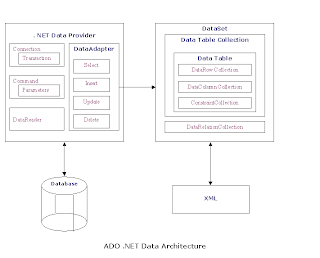
Data Access in ADO.NET relies on two components: DataSet and Data Provider.
DataSet
The dataset is a disconnected, in-memory representation of data. It can be considered as a local copy of the relevant portions of the database. The DataSet is persisted in memory and the data in it can be manipulated and updated independent of the database. When the use of this DataSet is finished, changes can be made back to the central database for updating. The data in DataSet can be loaded from any valid data source like Microsoft SQL server database, an Oracle database or from a Microsoft Access database.
Data Provider
The Data Provider is responsible for providing and maintaining the connection to the database. A DataProvider is a set of related components that work together to provide data in an efficient and performance driven manner. The .NET Framework currently comes with two DataProviders: the SQL Data Provider which is designed only to work with Microsoft's SQL Server 7.0 or later and the OleDb DataProvider which allows us to connect to other types of databases like Access and Oracle. Each DataProvider consists of the following component classes:
The Connection object which provides a connection to the database
The Command object which is used to execute a command
The DataReader object which provides a forward-only, read only, connected recordset
The DataAdapter object which populates a disconnected DataSet with data and performs update
Component classes that make up the Data Providers
The Connection Object
The Connection object creates the connection to the database. Microsoft Visual Studio .NET provides two types of Connection classes: the SqlConnection object, which is designed specifically to connect to Microsoft SQL Server 7.0 or later, and the OleDbConnection object, which can provide connections to a wide range of database types like Microsoft Access and Oracle. The Connection object contains all of the information required to open a connection to the database.
The Command Object
The Command object is represented by two corresponding classes: SqlCommand and OleDbCommand. command objects are used to execute commands to a database across a data connection. The command objects can be used to execute stored procedures on the database, SQL commands, or return complete tables directly. command objects provide three methods that are used to execute commands on the database:
ExecuteNonQuery: Executes commands that have no return values such as INSERT, UPDATE or DELETE
ExecuteScalar: Returns a single value from a database query
ExecuteReader: Returns a result set by way of a DataReader object
The DataReader Object
The DataReader object provides a forward-only, read-only, connected stream recordset from a database. Unlike other components of the Data Provider, DataReader objects cannot be directly instantiated. Rather, the DataReader is returned as the result of the Command object's ExecuteReader method. The SqlCommand.ExecuteReader method returns a SqlDataReader object, and the OleDbCommand.ExecuteReader method returns an OleDbDataReader object. The DataReader can provide rows of data directly to application logic when you do not need to keep the data cached in memory. Because only one row is in memory at a time, the DataReader provides the lowest overhead in terms of system performance but requires the exclusive use of an open Connection object for the lifetime of the DataReader.
The DataAdapter Object
The DataAdapter is the class at the core of ADO .NET's disconnected data access. It is essentially the middleman facilitating all communication between the database and a DataSet. The DataAdapter is used either to fill a DataTable or DataSet with data from the database with it's Fill method. After the memory-resident data has been manipulated, the DataAdapter can commit the changes to the database by calling the Update method. The DataAdapter provides four properties that represent database commands:
SelectCommand
InsertCommand
DeleteCommand
UpdateCommand
When the Update method is called, changes in the DataSet are copied back to the database and the appropriate InsertCommand, DeleteCommand, or UpdateCommand is executed.
|